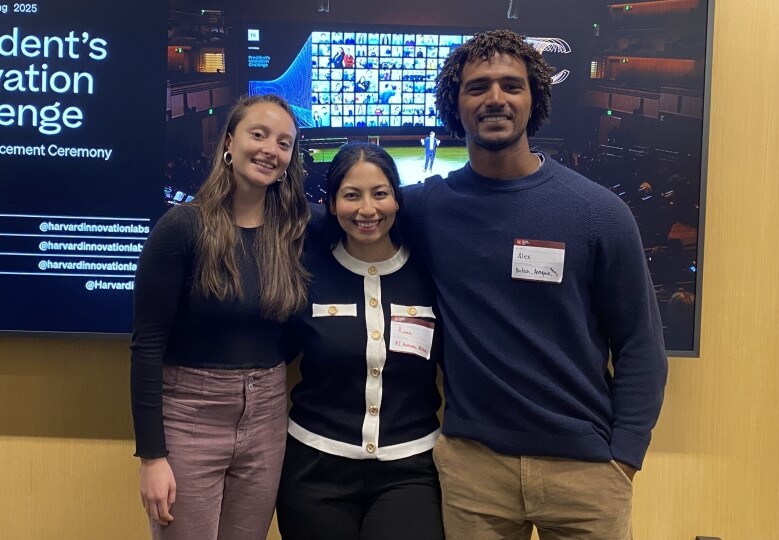News
For their senior capstone project, Gabby Troy, Roaa Marei and Alex Klein Wassink built a breathalyzer for early lung cancer detection
Engineering Design Projects (ES 100), the capstone course at the Harvard John A. Paulson School of Engineering and Applied Sciences (SEAS), challenges seniors to engineer a creative solution to a real-world problem.
SpiroSniff: An ML Driven Breathalyzer for Lung Cancer Detection
Roaa Marei, Alex Klein Wassink, S.B. '25, Mechanical Engineering, Gabby Troy, S.B. '25, Bioengineering
Advisor: Haritosh Patel & Jacopo Movilli
• Please give a brief summary of your project.
The goal of SpiroSniff is to develop a machine learning (ML)-driven, portable, and affordable breathalyzer for early lung cancer detection by analyzing volatile organic compounds (VOCs) in exhaled breath. This project aims to provide a non-invasive, rapid, and reliable alternative to existing diagnostic tools, which are often expensive and inaccessible. It is designed to be cost-effective, under $150 per unit, and scalable for widespread use, including in resource-limited settings, to improve public health through early diagnosis.
• How did you come up with this idea for your final project?
The Aizenberg Lab has been leading an effort into developing e-noses for various applications ranging from indoor air quality monitoring to methane monitoring from cattle. One of their challenging projects in this portfolio was the development of a breathalyzer for disease detection. We were drawn to the intersection of health, technology, and accessibility that this project represented.
• Is there a real-world challenge that this project addresses?
Existing methods for detecting lung cancer from breath samples are typically costly, difficult to scale, and lack specificity – especially outside controlled lab environments. For example, Gas Chromatography-Mass Spectrometry (GC-MS), the most common technique, identifies and quantifies compounds in breath. However, GC-MS is expensive, requires specialized training, and is only available in labs, making it impractical for routine or widespread use. SpiroSniff seeks to address these barriers with a low-cost, user-friendly, and scalable solution.
• What was the timeline of your project?
Our project unfolded over several key phases. We began with system setup and a robust data collection phase to gather raw sensor data. This was followed by a device design phase, which spanned the end of the first semester and continued into the second. The final phase focused on machine learning – specifically, feature extraction, model development, and data analysis, culminating in the final presentation near the end of the year.
• What part of the project proved the most challenging?
One of the most difficult aspects was replicating realistic breath samples by creating precise gas concentrations for testing. Additionally, thinking through the user experience – how users would interact with the device and interpret its outputs – posed both design and ethical challenges. Still, we tackled each obstacle step by step with the guidance of our advisors and strong team collaboration.
• What part of the project did you enjoy the most
Seeing our vision evolve from initial sketches to a functioning breathalyzer was incredibly rewarding. Watching the physical device take shape after months of hard work was a highlight and a testament to our collective effort.
• What did you learn, or skills did you gain, through this project?
We gained hands-on experience in system setup, sensor integration and device design. We also deepened our understanding of machine learning, coding, and chemical concentration calculations. Each of us focused on areas that aligned with our individual interests, but we also learned extensively from one another. Overall, the project strengthened our skills in engineering, data science, chemistry, and human-centered design.
Topics: Academics, Bioengineering, Health / Medicine, Materials Science & Mechanical Engineering
Cutting-edge science delivered direct to your inbox.
Join the Harvard SEAS mailing list.
Press Contact
Matt Goisman | mgoisman@g.harvard.edu



